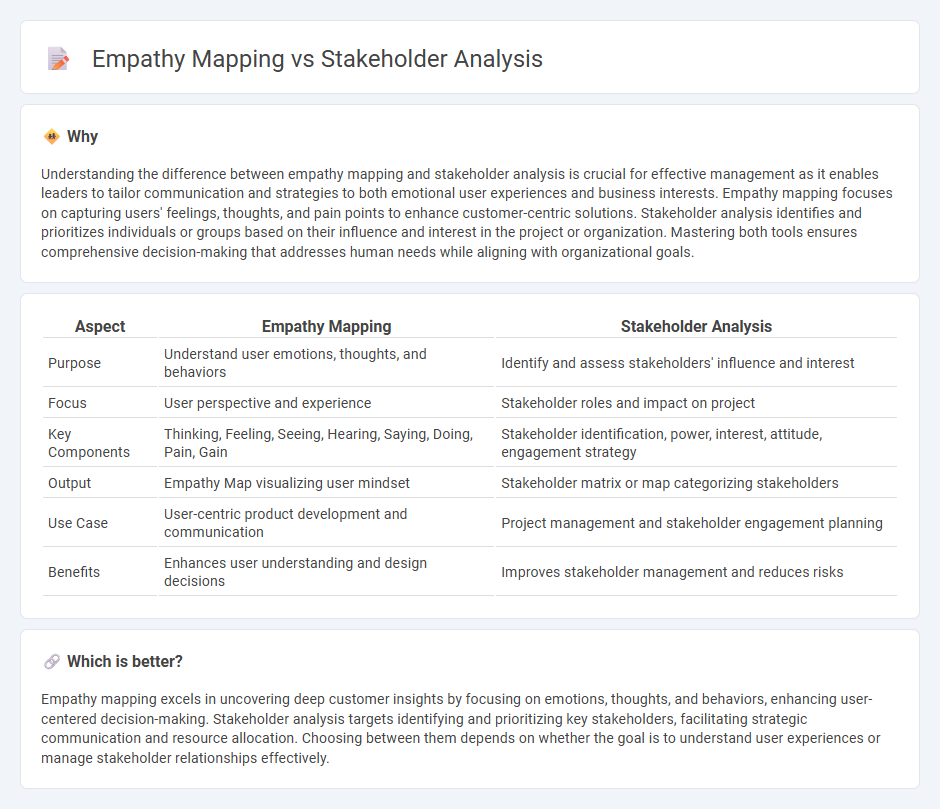
Empathy mapping focuses on understanding users' emotions, thoughts, and behaviors to enhance customer-centric strategies, while stakeholder analysis identifies and prioritizes individuals or groups influencing a project's success. Both tools optimize decision-making by aligning management approaches with human factors and organizational goals. Explore these techniques further to improve stakeholder engagement and user experience.
Why it is important
Understanding the difference between empathy mapping and stakeholder analysis is crucial for effective management as it enables leaders to tailor communication and strategies to both emotional user experiences and business interests. Empathy mapping focuses on capturing users' feelings, thoughts, and pain points to enhance customer-centric solutions. Stakeholder analysis identifies and prioritizes individuals or groups based on their influence and interest in the project or organization. Mastering both tools ensures comprehensive decision-making that addresses human needs while aligning with organizational goals.
Comparison Table
| Aspect | Empathy Mapping | Stakeholder Analysis |
|---|---|---|
| Purpose | Understand user emotions, thoughts, and behaviors | Identify and assess stakeholders' influence and interest |
| Focus | User perspective and experience | Stakeholder roles and impact on project |
| Key Components | Thinking, Feeling, Seeing, Hearing, Saying, Doing, Pain, Gain | Stakeholder identification, power, interest, attitude, engagement strategy |
| Output | Empathy Map visualizing user mindset | Stakeholder matrix or map categorizing stakeholders |
| Use Case | User-centric product development and communication | Project management and stakeholder engagement planning |
| Benefits | Enhances user understanding and design decisions | Improves stakeholder management and reduces risks |
Which is better?
Empathy mapping excels in uncovering deep customer insights by focusing on emotions, thoughts, and behaviors, enhancing user-centered decision-making. Stakeholder analysis targets identifying and prioritizing key stakeholders, facilitating strategic communication and resource allocation. Choosing between them depends on whether the goal is to understand user experiences or manage stakeholder relationships effectively.
Connection
Empathy mapping and stakeholder analysis are interconnected tools in management that enhance understanding of stakeholder needs and motivations. Empathy mapping deepens insight into stakeholders' emotions, thoughts, and behaviors, which complements stakeholder analysis by identifying and prioritizing key individuals or groups. Together, they enable managers to create more targeted strategies by aligning project goals with stakeholder expectations and concerns.
Key Terms
**Stakeholder Analysis:**
Stakeholder analysis identifies and categorizes individuals or groups affected by a project based on their power, interest, and influence to prioritize engagement strategies. It systematically evaluates stakeholders' needs and potential impacts on project success, ensuring resource allocation aligns with critical relationships. Explore in-depth how stakeholder analysis can enhance project management and decision-making.
Power/Influence
Stakeholder analysis centers on identifying individuals or groups with significant power and influence over a project's outcome, facilitating strategic engagement and resource allocation. Empathy mapping, by contrast, emphasizes understanding stakeholders' emotions, needs, and motivations to foster deeper connection and cooperation. Explore more to enhance your project management skills with these crucial tools.
Interest
Stakeholder analysis prioritizes identifying and categorizing stakeholders based on their interest and influence in a project to ensure targeted engagement strategies. Empathy mapping emphasizes understanding stakeholders' feelings, motivations, and needs to foster deeper emotional connections and user-centered designs. Explore how these tools complement each other to enhance stakeholder management and project outcomes.
Source and External Links
Stakeholder analysis - Wikipedia - Stakeholder analysis is a process used to assess the interests and influence of relevant parties in relation to a project or system, identifying how their needs should be addressed to effectively manage stakeholder relationships.
How to Perform a Stakeholder Analysis | Lucidchart - The three-step process of stakeholder analysis includes identifying stakeholders, prioritizing them based on influence and interest, and tailoring communication and engagement accordingly to ensure project success.
What Is Stakeholder Analysis? Definition, Examples and Template - Stakeholder analysis involves identifying individuals or groups affected by or able to influence a project and understanding their needs and expectations to plan engagement strategies that support project goals and mitigate risks.
 dowidth.com
dowidth.com